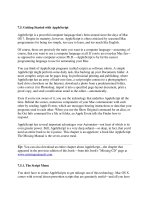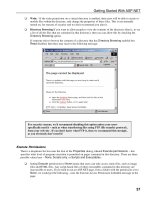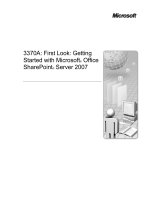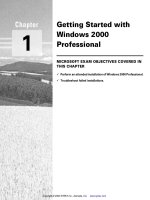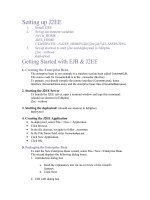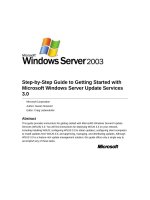Getting started with adobe flex
Bạn đang xem bản rút gọn của tài liệu. Xem và tải ngay bản đầy đủ của tài liệu tại đây (3.93 MB, 235 trang )
G E T T I N G S T A R T E D W I T H
Adobe Flex
Amitava Kundu, Charu Agarwal, Anushka Chandrababu, Mukul Kumar, Karthik
Ramanarayanan, Raul F. Chong
F I R S T E D I T I O N
A book for the community by the community
4 Getting Started with Adobe Flex
First Edition (May 2010)
© Copyright IBM Corporation 2010. All rights reserved.
IBM Canada
8200 Warden Avenue
Markham, ON
L6G 1C7
Canada
Notices
This information was developed for products and services offered in the U.S.A.
IBM may not offer the products, services, or features discussed in this document in other countries.
Consult your local IBM representative for information on the products and services currently available
in your area. Any reference to an IBM product, program, or service is not intended to state or imply
that only that IBM product, program, or service may be used. Any functionally equivalent product,
program, or service that does not infringe any IBM intellectual property right may be used instead.
However, it is the user's responsibility to evaluate and verify the operation of any non-IBM product,
program, or service.
IBM may have patents or pending patent applications covering subject matter described in this
document. The furnishing of this document does not grant you any license to these patents. You can
send license inquiries, in writing, to:
IBM Director of Licensing
IBM Corporation
North Castle Drive
Armonk, NY 10504-1785
U.S.A.
For license inquiries regarding double-byte character set (DBCS) information, contact the IBM
Intellectual Property Department in your country or send inquiries, in writing, to:
Intellectual Property Licensing
Legal and Intellectual Property Law
IBM Japan, Ltd.
3-2-12, Roppongi, Minato-ku, Tokyo 106-8711
The following paragraph does not apply to the United Kingdom or any other country where
such provisions are inconsistent with local law: INTERNATIONAL BUSINESS MACHINES
CORPORATION PROVIDES THIS PUBLICATION "AS IS" WITHOUT WARRANTY OF ANY KIND,
EITHER EXPRESS OR IMPLIED, INCLUDING, BUT NOT LIMITED TO, THE IMPLIED
WARRANTIES OF NON-INFRINGEMENT, MERCHANTABILITY OR FITNESS FOR A
PARTICULAR PURPOSE. Some states do not allow disclaimer of express or implied warranties in
certain transactions, therefore, this statement may not apply to you.
This information could include technical inaccuracies or typographical errors. Changes are
periodically made to the information herein; these changes will be incorporated in new editions of the
publication. IBM may make improvements and/or changes in the product(s) and/or the program(s)
described in this publication at any time without notice.
Any references in this information to non-IBM Web sites are provided for convenience only and do
not in any manner serve as an endorsement of those Web sites. The materials at those Web sites
are not part of the materials for this IBM product and use of those Web sites is at your own risk.
IBM may use or distribute any of the information you supply in any way it believes appropriate without
incurring any obligation to you.
6 Getting Started with Adobe Flex
The licensed program described in this document and all licensed material available for it are
provided by IBM under terms of the IBM Customer Agreement, IBM International Program License
Agreement or any equivalent agreement between us.
Any performance data contained herein was determined in a controlled environment. Therefore, the
results obtained in other operating environments may vary significantly. Some measurements may
have been made on development-level systems and there is no guarantee that these measurements
will be the same on generally available systems. Furthermore, some measurements may have been
estimated through extrapolation. Actual results may vary. Users of this document should verify the
applicable data for their specific environment.
Information concerning non-IBM products was obtained from the suppliers of those products, their
published announcements or other publicly available sources. IBM has not tested those products and
cannot confirm the accuracy of performance, compatibility or any other claims related to non-IBM
products. Questions on the capabilities of non-IBM products should be addressed to the suppliers of
those products.
All statements regarding IBM's future direction or intent are subject to change or withdrawal without
notice, and represent goals and objectives only.
This information contains examples of data and reports used in daily business operations. To
illustrate them as completely as possible, the examples include the names of individuals, companies,
brands, and products. All of these names are fictitious and any similarity to the names and addresses
used by an actual business enterprise is entirely coincidental.
COPYRIGHT LICENSE:
This information contains sample application programs in source language, which illustrate
programming techniques on various operating platforms. You may copy, modify, and distribute these
sample programs in any form without payment to IBM, for the purposes of developing, using,
marketing or distributing application programs conforming to the application programming interface
for the operating platform for which the sample programs are written. These examples have not been
thoroughly tested under all conditions. IBM, therefore, cannot guarantee or imply reliability,
serviceability, or function of these programs. The sample programs are provided "AS IS", without
warranty of any kind. IBM shall not be liable for any damages arising out of your use of the sample
programs.
References in this publication to IBM products or services do not imply that IBM intends to make
them available in all countries in which IBM operates.
If you are viewing this information softcopy, the photographs and color illustrations may not appear.
Adobe product screenshot(s) reprinted with permission from Adobe Systems Incorporated.
Trademarks
IBM, the IBM logo, and ibm.com are trademarks or registered trademarks of International Business
Machines Corp., registered in many jurisdictions worldwide. Other product and service names might
be trademarks of IBM or other companies. A current list of IBM trademarks is available on the Web at
“Copyright and trademark information” at www.ibm.com/legal/copytrade.shtml.
Adobe, the Adobe logo, Flex, Flex Builder, PostScript, and the PostScript logo are either registered
trademarks or trademarks of Adobe Systems Incorporated in the United States, and/or other
countries.
Java and all Java-based trademarks are trademarks of Sun Microsystems, Inc. in the United States,
other countries, or both.
Microsoft and Windows are trademarks of Microsoft Corporation in the United States, other countries,
or both.
Linux is a registered trademark of Linus Torvalds in the United States, other countries, or both.
UNIX is a registered trademark of The Open Group in the United States and other countries.
Other company, product, or service names may be trademarks or service marks of others.
9
Table of Contents
Preface 14
Who should read this book? 14
How is this book structured? 14
A book for the community 15
Conventions 15
What’s next? 15
About the Authors 17
Contributors 19
Acknowledgements 19
Chapter 1 – Introduction to Adobe Flex 20
1.1 A brief history of Adobe Flex 20
1.2 Pros and cons of Flex applications 25
1.3 Versions and editions of Adobe Flex 26
1.3.1 Adobe Flex 3 SDK 26
1.3.2 Adobe Flex Builder 3 26
1.3.3 Adobe Data Services 27
1.4 The Flex Community 27
1.4.1 Developer Resources 27
1.4.2 Discussion Forums 28
1.4.3 Adobe Flex Blogs 28
1.5 Comparing Adobe Flex with similar products 28
1.5.1 Adobe Flex and HTML/JavaScript/Ajax 28
1.5.2 Adobe Flex and Flash IDE 29
1.5.3 Adobe Flex and Java/JavaFX 29
1.5.4 Adobe Flex and Java Server Faces (JSF) 29
1.5.5 Adobe Flex and Microsoft Silverlight 30
1.6 Summary 30
1.7 Review questions 30
Chapter 2 – Installing Flex 32
2.1 Installing Flex: The big picture 32
2.2 Installing Flex using the setup wizard 33
2.2.1 Installing Eclipse 33
2.2.2 Installing Flex Builder 33
2.3 Launching Flex Builder 38
2.4 Developing your first Flex application 40
2.4.1 Building and running the "Hello Flex" application 40
2.4.2 Debugging the Flex application 50
2.5 Exercises 53
2.6 Summary 53
2.7 Review questions 53
Chapter 3 - Introduction to MXML and ActionScript 55
3.1 MXML and ActionScript – the Big Picture 55
3.2 MXML 57
10 Getting Started with Adobe Flex
3.2.1 XML 57
3.2.2 Anatomy of an XML tag 58
3.2.3 Namespaces in MXML 59
3.3 ActionScript 3 59
3.3.1 Inline ActionScript 59
3.3.2 MXML Scripts 60
3.3.3 ActionScript Variables and data types 60
3.3.4 ActionScript Classes and Objects 61
3.3.5 Functions and Access modifiers 63
3.3.6 [Bindable] Tag 64
3.3.7 MXML and ActionScript mapping 65
3.3.8 Events 67
3.4 Exercises 69
3.5 Summary 72
3.6 Review Questions 72
Chapter 4 - Working with Flex components 75
4.1 Working with Flex components: The big picture 75
4.2 Components 78
4.3 Containers 79
4.3.1 Application containers 79
4.3.2 Layout containers 80
4.3.3 Navigation containers 81
4.4 Controls 83
4.4.1 Text-based controls 83
4.4.2 Basic controls 85
4.4.3 Menu-based controls 89
4.4.4 Data-driven controls 89
4.5 Exercises 90
4.6 Summary 94
4.7 Review questions 94
Chapter 5 - Binding data between controls 97
5.1 Data binding – The big picture 97
5.2 Ways to achieve data binding 98
5.2.1 Curly braces ({}) syntax 98
5.2.2 ActionScript expressions in curly braces ({}) 98
5.2.3 <mx:binding> tag in MXML 99
5.2.4 Bindings in ActionScript 99
5.3 Data storage structures and mechanisms 100
5.3.1 Array 100
5.3.2 XML 101
5.3.3 XMLList 101
5.3.4 Flex data management classes 102
5.4 Data Driven UI Controls 103
5.4.1 Scrolling List controls 104
5.4.2 DataGrid control 106
11
5.4.3 AdvancedDataGrid control 107
5.4.4 Hierarchical Data Controls 109
5.5 Item renderer controls 111
5.5.1 Drop-In item renderer 112
5.5.2 Inline item renderer 112
5.5.2 Custom item renderer 113
5.6 Summary 113
5.7 Review questions 113
Chapter 6 - Working with view states, transitions and filters 115
6.1 Working with view states, transitions and filters: The big picture 115
6.2 View states 116
6.2.1 Creating States 116
6.2.2 State properties, style and events 120
6.2.3 Adding components 121
6.3 Behaviors 122
6.3.1 Common Effects 122
6.3.2 Using Effects 123
6.3.3 Customizing Effects 124
6.4 Transitions 124
6.4.1 Making states more interesting 125
6.4.2 Using Action Effects 125
6.5 Filters 126
6.5.1 Common Filters 127
6.5.2 Applying Filters 127
6.6 Exercises 128
6.7 Summary 134
6.8 Review questions 134
Chapter 7 - Working with the server 137
7.1 Working with the server: The big picture 137
7.2 Working with Web services 138
7.2.1 The <mx:WebService> tag 140
7.2.2. The send() method 140
7.2.3 The ResultEvent object 140
7.2.4 The FaultEvent object 141
7.2.5 The result property 141
7.2.6 The fault property 141
7.2.7 The service property 141
7.2.8 The <mx:operation> tag 141
7.2.9 The <mx:request> tag 141
7.2.10 Sample Application 142
7.3 Using Remote object 144
7.3.1 The <mx:RemoteObject> tag 144
7.3.2 <mx:method> tag 145
7.3.3 <mx:arguments> tag 145
7.4 Using HTTPService 145
12 Getting Started with Adobe Flex
7.4.1 The <mx:HTTPService> tag 146
7.4.2 The send ( ) method 146
7.4.3 The <mx:Request> tag 147
7.4.4 The LastResult property 147
7.4.5 Sample application that uses HTTPService 147
7.4.6 Using the result and fault events 149
7.4.7 Using the E4X Format 149
7.5 Working with databases 150
7.5.1 Sample Flex application accessing a DB2 database 150
7.6 Exercises 171
7.6.1 Exercise 1 - Obtaining weather forecast information 171
7.6.2 Exercise 2 - Desktop application to translate text 175
7.7 Summary 178
7.8 Review questions 178
Chapter 8 - Data Visualization 181
8.1 Flex Charting: The big picture 181
8.2 Different Charts in Flex 3 182
8.2.1 Area Chart [AreaChart] 182
8.2.2 Bar Chart [BarChart] 182
8.2.3 Bubble Chart [BubbleChart] 183
8.2.4 Candle Stick Chart [CandlestickChart] 183
8.2.5 Column Chart [ColumnChart] 183
8.2.6 Legend Control [Legend] 183
8.2.7 High Low Open Close Chart [HLOCChart] 183
8.2.8 Line Chart [LineChart] 183
8.2.9 Pie Chart [PieChart] 184
8.2.10 Plot Chart [PlotChart] 184
8.3 Column chart example 185
8.4 Bar chart example 186
8.5 Line chart example 187
8.6 Area chart example 189
8.7 Pie chart example 190
8.8 Chart style 192
8.8.1 Stroke 192
8.8.2 Stacking 192
8.8.3 Fill 193
8.9 Exercises 193
8.9 Summary 197
8.10 Review questions 197
Appendix A – Solutions to review questions 201
Appendix B – Up and running with DB2 211
B.1 DB2: The big picture 211
13
B.2 DB2 Packaging 212
B.2.1 DB2 servers 212
B.2.2 DB2 Clients and Drivers 213
B.3 Installing DB2 214
B.3.1 Installation on Windows 214
B.3.2 Installation on Linux 215
B.4 DB2 Tools 215
B.4.1 Control Center 215
B.4.2 Command Line Tools 217
B.5 The DB2 environment 220
B.6 DB2 configuration 221
B.7 Connecting to a database 222
B.8 Basic sample programs 223
B.9 DB2 documentation 225
References 227
Resources 229
Web sites 229
Contact emails 232
14
Preface
Keeping your skills current in today's world is becoming increasingly challenging. There are
too many new technologies being developed, and little time to learn them all. The DB2® on
Campus Book Series has been developed to minimize the time and effort required to learn
many of these new technologies.
Who should read this book?
This book is intended for anyone who works or intends to work with Web application design
and development using the Web 2.0 paradigm such as application developers, software
architects, consultants, instructors and students.
How is this book structured?
Chapter 1 - Introduction to Adobe® Flex®, provides a brief history of Adobe Flex,
introduces various resources related to Flex, and compares it with other competitive
products.
Chapter 2 - Installing Flex, discusses Flex installation options, the Eclipse Plugin for Flex®
Builder™, and how to start working with a Flex program.
Chapter 3 - Introduction to MXML™ and ActionScript®, introduces you to MXML basics,
ActionScript fundamentals, the relationship between MXML and ActionScript, and also
provides an introduction to events.
Chapter 4 - Working with Flex components, introduces you to Flex containers and controls.
Chapter 5 - Binding data between controls, explains what is data binding and the methods
to achieve data binding. It also discusses about data storage structures and mechnisms,
and UI controls driven by data.
Chapter 6 - Working with view states, transitions and filters explains how to work with
states, properties, style and events, behaviors, effects, transitions, and filters.
Chapter 7 - Working with the server, teaches you how to invoke Web services, how to work
with remote objects, and how to use the HTTPService from a Flex application. It also
provides a sample Flex application that accesses a DB2 database.
Chapter 8 - Data Visualization, talks about Flex charting, how to work with different charts
and their common usage.
Appendix A contains the solutions to the review questions at the end of each chapter.
Appendix B contains information that can get you started with DB2 in minutes.
Exercises are provided with most chapters; any input files required for these labs are
provided in the zip file Exercise_Files_AdobeFlex.zip accompanying this book.
15
A book for the community
This book was created by the community; a community consisting of university professors,
students, and professionals (including IBM employees). The online version of this book is
released to the community at no-charge. Numerous members of the community from
around the world have participated in developing this book, which will also be translated to
several languages by the community. If you would like to provide feedback, contribute new
material, improve existing material, or help with translating this book to another language,
please send an email of your planned contribution to
with the subject
“Adobe Flex book feedback.”
Conventions
Many examples of commands, SQL statements, and code are included throughout the
book. Specific keywords are written in uppercase bold. For example: A NULL value
represents an unknown state. Commands are shown in lowercase bold. For example: The
dir command lists all files and subdirectories on Windows. SQL statements are shown in
upper case bold. For example: Use the SELECT statement to retrieve information from a
table.
Object names used in our examples are shown in bold italics. For example: The flights
table has five columns.
Italics are also used for variable names in the syntax of a command or statement. If the
variable name has more than one word, it is joined with an underscore. For example:
CREATE TABLE table_name
What’s next?
We recommend you to review the following books in this book series for more details about
related topics:
Getting started with DB2 Express-C
Getting started with IBM Data Studio for DB2
Getting started with Eclipse
Getting started with Web 2.0
The following figure shows all the different ebooks in the DB2 on Campus book series
available for free at
db2university.com
16 Getting Started with Adobe Flex
The DB2 on Campus book series
17
About the Authors
Amitava Kundu is a Senior Software Engineer and architect based at India Software Lab,
Bangalore, India. His main responsibility is in the area of tools related to performance
monitoring, tuning and management for various data servers and application stacks. As a
technical lead, he’s involved with suit of product developments using Adobe Flex. Prior to
this role, he’s part of IBM Rational group, where he was leading the functional and
technical team for Project Portfolio Management (PPM) team. Amitava has more than 16
year of IT experience and he’s with IBM since 2005.
Karthik Ramanarayanan is an Advisory Software Engineer based at India Software Lab,
Bangalore, India. He is currently involved with product development in the area of tools
related to performance monitoring and management using Adobe Flex along with other
technologies. Prior to this role, He was a part of IBM Rational group where he was involved
with the Project Portfolio Management team working with DB2 and Oracle technologies.
Karthik has more than 12 years of IT Experience and he has been with IBM Since 2007.
Charu Agarwal is a System Software Engineer with India Software Labs, IBM, Bangalore.
She is currently involved in developing tools related to performance monitoring and
optimization using Adobe Flex with other server-side technologies. Prior to this role, she
was involved in developing applications for the healthcare domain and has significant
experience in database internals and Web 2.0 application development. She has more
than 4 years of IT Experience and has been with IBM since 2008.
Mukul Kumar is working as System Software Engineer with India Software Lab, IBM. Out
of a total work experience of 4 years and 6 months, he spent more than 3 years developing
Web applications using Java™, J2EE and related technologies and framework. He is
currenlty working with OPM development team where OSGi and Flex are the main stream
of interest and developement.
Anushka Chandrabau is working as System Software Engineer in India Software Lab,
Bangalore, India. She has a Bachelor Degree in Computer Sceince and Engineering and a
Masters in Information Technolgy. Since Joining IBM in 2008, Anushka has been working
as a developer for Optim Data Studio suite of products. She’s a key designer and
developer using Flex technologies for the new web based product development.
Raul F. Chong is the DB2 on Campus program manager based at the IBM Toronto
Laboratory, and a DB2 technical evangelist. His main responsibility is to grow the DB2
community around the world, helping members interact with one another, and contributing
to the DB2 forums. Raul joined IBM in 1997 and has held numerous positions in the
company. As a DB2 consultant, Raul helped IBM business partners with migrations from
other relational database management systems to DB2, as well as with database
performance and application design issues. As a DB2 technical support specialist, Raul
has helped resolve DB2® problems on the OS/390®, z/OS®, Linux®, UNIX® and
Windows® platforms. Raul has also worked as an information developer for the Application
Development Solutions team where he was responsible for the CLI guide and Web
services material. Raul has taught many DB2 workshops, has published numerous articles,
18 Getting Started with Adobe Flex
and has contributed to the DB2 Certification exam tutorials. Raul has summarized many of
his DB2 experiences through the years in his book Understanding DB2 - Learning Visually
with Examples 2nd Edition (ISBN-10: 0131580183) for which he is the lead author. He has
also co-authored the book DB2 SQL PL Essential Guide for DB2 UDB on Linux, UNIX,
Windows, i5/OS, and z/OS (ISBN 0131477005), and is the project lead and co-author of
the books in the DB2 on Campus Book Series.
19
Contributors
The following people edited, reviewed, and contributed significantly to this book.
Contributor Company/University Position/Occupation Contribution
Leon
Katsnelson
IBM Toronto Lab
Program Director, IBM
Data Servers
Technical
review
Acknowledgements
We greatly thank the following individuals for their assistance in developing materials
referenced in this book:
Natasha Tolub and Natasha Maxim for designing the cover of this book.
Susan Visser for assistance with publishing this book.
1
Chapter 1 – Introduction to Adobe Flex
Adobe® Flex® is a free open source framework for developing rich Web applications that
deploy consistently on all major browsers, desktops, and operating systems. Essentially, it
is a software development kit (SDK) released by Adobe Systems that allows Web
developers to rapidly and easily build Rich Internet Applications (RIAs) on the Flash®
Platform.
Adobe Flex aims to provide a client-side Flash-based rich client that can run on the
desktop as well as embedded in a Web page. Its focus is targeted on the client only,
exchanging data asynchronously with the any server technology supporting HTTP. Data
interchange is XML-based, so the product is not tied to any particular communication
framework or technology. The server-supported technologies include Java™ EE, Microsoft
.NET framework, PHP, Web Services, and any other framework capable of sending and
receiving XML data
In this chapter you will learn about:
A brief history of Adobe Flex
Versions and releases of Adobe Flex
The Adobe Flex community and resources
Products competing with Adobe Flex
1.1 A brief history of Adobe Flex
Before describing the history of Adobe Flex, you need to understand the evolution of
application development that led to the development of rich internet application
frameworks. Figure 1.1 illustrates this evolution.
Chapter 1 – Introduction to Adobe Flex 21
Figure 1.1 – Evolution of application development
Note:
Since this book focuses on the distributed platforms such as Linux, UNIX, Windows and
the Mac; mainframe applications are not discussed.
In the early 90's applications were developed to be run mainly on individual desktops.
These applications were rich and robust allowing users and developers to perform
practically anything allowed by the the operating system. The main disadvantage of these
applications; however, lied in its deployment model: On one hand, users had to constantly
get new CDs to install an upgrade or fix. On the other hand, developers had to consider
supporting multiple versions for different clients. This is because each user was tied to his
own copy of the application as shown in Figure 1.2.
Figure 1.2 – Desktop Applications, each user is tied to his own copy
By the mid 90's, with the internet technological boom, Web applications started to become
popular. In Figure 1.1 they are illustrated as "traditional" Web applications because at the
time, there was no technology to make these applications rich, that is; flexible, engaging,
containing videos, and other interesting features. Web applications run on a centralized
computer. Though traditional Web applications were not rich, developers found these
applications quite convenient to deploy enhancements and fixes quickly because Web
application were deployed on a central computer and accessed by all users as illustrated in
Figure 1.3 below. Updates needed to be made only on the central computer.
22 Getting Started with Adobe Flex
Figure 1.3 – Web application advantage: Centralized Deployment
Figure 1.4 shows an example of a traditional Web site; it is a ficticious Web site called
"Eureka!!", but very similar to Web sites of the early 90's. Due to bandwidth restrictions,
graphics were kept to a minimum. There was no dynamic content (the pages were static)
and normally only text data with hyperlinks to other pages were displayed.
Figure 1.4 – Example of look & feel of Traditional Web site
The main problem with traditional Web applications was that they offered poor user
experience compared to desktop applications. Yet, developers still preferred Web
applications because they were platform independent, and more convenient for upgrade
and deployment.
Technologies such as Java Script and cascading style sheets (CSS) helped alleviate the
problem to some extent, but usability issues persisted because the Web was historically
designed to be a documentation-distribution mechanism, where text and hyperlinks were
enough.
Through the years, developers tried to improve usability by transferring as much
application logic as possible to the front-end in order to mimic a desktop-like experience.
Chapter 1 – Introduction to Adobe Flex 23
However, the more application logic was pushed to the client side, the more browser
incompatibilities started to arise. This was ironically what Web development wanted to
prevent with platform-independent applications.
By the mid 2000's, Rich Internet Applications (RIAs) were developed with new technologies
such as Adobe Flex. RIAs offer a Web experience that is engaging, interactive, lightweight
and flexible. A RIA combines the benefits of using the Web as a low-cost deployment
model with a rich user experience that is as good as desktop applications. RIAs introduced
a new model for application development which separated the back-end data services from
a rich front-end client. An example of a RIA can be seen by visiting the Flex Store at
Figure 1.5 below
illustrates a sample RIA Web site.
Figure 1.5 – Rich Internet Application Example: Sample e-Retail Store
RIAs bring true platform neutrality: The same application yields the same look and feel
regardless of the environment. This is accomplished primarily through the use of a browser
plug-in (for various browsers and operating systems) that acts as a local runtime engine.
Using the browser as a delivery mechanism provides a high degree of deployability.
Rich Internet Applications eliminate a lot of the network traffic typically seen with traditional
Web applications, especially when working with dynamic pages. Traditional Web
applications sent requests out over a series of routers on the World Wide Web until a Web
server was reached. The Web Server then packaged the HTML pages and sent them back
to the browser which read the HTML and displayed the page.
For a dynamic page, the Web server forwarded the request to an application server where
business logic was implemented. The application server generated dynamic HTML content
24 Getting Started with Adobe Flex
and would send this back to the Web Server which forwarded it to the browser for display.
The implementation of dynamic Web pages was not very efficient because a lot of network
traffic was involved.
With RIAs system performance is substantially improved by doing a lot more of the
processing on the client than a thin client Web Application. RIAs are stateful and they are
not a set of pages controlled by the server as in traditional Web applications but they are
actual applications running on the clients’ computer and only communicate with servers to
process and exchange data.
In March of 2004 Adobe Flex made its debut with version 1.0. This version, as well as
version 1.5 of Adobe Flex, were expensive server-based products. They were based on
Flash® Player 7.0 and ActionScript 2.0, and they even had their own Dreamweaver®-like
development tool called Flex Builder
. These versions never gained popularity due to the
limitations of ActionScript 2.0.
With the release of Adobe Flex 2 in June 2006, Flex became an entirely client-side product.
Adobe rewrote the entire Flex framework and IDE from scratch. Central to the change was
the introduction of ActionScript 3.0
. Flex 2 was based on Flash Player 9.0 and Action Script
3.0. Adobe decided not to upgrade the Dreamweaver-like Flex Builder 1.0 but rather start
using Eclipse and providing a Flex Builder plug-in for Eclipse. Adobe Flex 2.0 offered a way
to create RIAs without incurring expensive licensing fees.
In February 2008 Adobe Flex 3 was released. Adobe Flex 3 added more functionality to
Flex Builder, such as refactoring and enhanced styling support as well as new data
visualization components in the Flex Framework. Adobe Flex 3 is also the official open-
source release of the Flex SDK and Flex compiler. As of the time of writing, Adobe Flex 3
is the most current version of Flex, and this is the version we will use in this book.
Adobe Flex 3 comes with a lot of new, key features including:
The profiler, to monitor memory and CPU Consumption
Refactoring, which makes it easy to rename almost anything, such as functions,
variables, and classes.
The Adobe Integrated Runtime (AIR®) framework that supports building cross-OS
rich internet application that can access local desktop resources.
Persistent Caching, which reduces the SWF File Size.
Wizards, to generate code thus reducing the hand coding effort.
Charting enhancements
A DataGrid component to display tabular data. The Advanced DataGrid provides
additional abilities such as multicolumn sorting and column spanning.
Flex Data Services which has been renamed to LiveCycle® Data Services now has
Support for Ajax Data Servers.
Memory and Performance Profilers.
Chapter 1 – Introduction to Adobe Flex 25
1.2 Pros and cons of Flex applications
Today, Web developers have a vast array of choices to develop RIAs, AJAX being one. So
why use Adobe Flex? One reason is the fact that Adobe Flex separates the presentation
and data access layers. This means that the Flex application is independent of the back-
end: You can use any server technology that meets your requirements ColdFusion,
J2EE, PHP, .NET, etc. Because so much of Adobe Flex is designed around XML (even the
MXML document), you can use something as basic as an HTTPService call to read and
write data to your data store.
The other main reason is that Adobe Flex is an ideal technology when you want to create
highly interactive, expressive Web site applications using and visualizing data. Adobe Flex
allows you to break out of the usual static web page and embed mini-applications without
the complexity and compatibility issues of alternatives like Java applets.
Listed below are the some other reasons to consider Adobe Flex for your Web site:
It helps build robust applications that attractively display complex data sets.
It is visually engaging to the visitors of your site.
It works on all the major platforms and users don’t need to install anything other
than a Flash player.
Audio and video allow for even greater interaction.
Data Synchronization allows for real-time data to be used more efficiently
On the other hand, Adobe Flex may not be the answer to all your needs. For example, if
you are planning to develop small applications with simple animation without writing much
code, Flash may be the best choice on a timeline based animation utility. Flex applications
are limited by the constraints of the Flash player. Also, a Flex application may be large in
size because it is based upon several libraries. Fortunately, Adobe Flex doesn’t force you
to use all of the Flex components (or even MXML) and allows an Action Script project to be
compiled on a free Flex compiler.
If you are planning a Web site that requires vast amount of rich text, or need only simple
user interaction, one might be better off using HTML/Ajax. Though Adobe Flex provides
great support for HTML, few projects may suffer a bit of performance lag if there is a lot of
text. However in case you want to deploy your applications to AIR, Adobe Flex is a good
choice as AIR provides native support for HTML. Using Flash or Flash along with HTML is
a good bet for Web sites with loads of text, animations and bits of interactivity.
In a Multitier model, Flex applications can serve as the presentation tier. Flex applications
are Web-based, but provide good levels of interactivity and rich media experiences that
make them look more like computer desktop programs.


